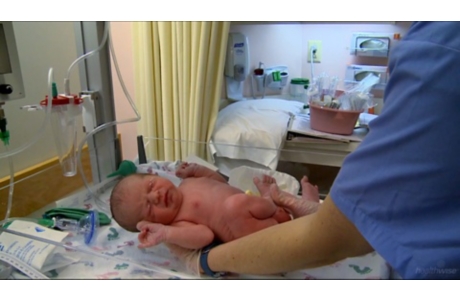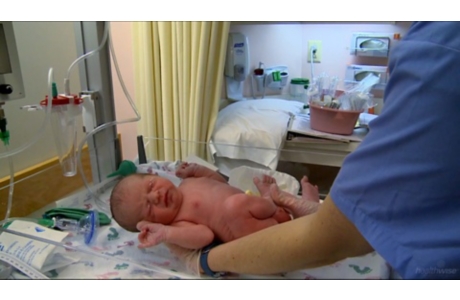Vaginal Birth After Cesarean (VBAC)
Condition Basics
What is a vaginal birth after cesarean (VBAC)?
Vaginal birth after cesarean (VBAC) means delivering your baby through the birth canal after you had a cesarean section (C-section), Opens dialog for an earlier birth. VBAC is often safe, but it does have some risks. And it may not succeed. You may not be able to complete the birth through the vagina.
If you and your doctor agree to try a VBAC, you will have what is called a "trial of labor after cesarean," or TOLAC. This means that you plan to go into labor with the goal to deliver through the birth canal. But as in any labor, it's hard to know if a VBAC will work. You still may need a C-section.
Is a VBAC safe?
Having a vaginal birth after having a C-section can be a safe choice. Whether it's right for you depends on several things, such as why you had a C-section before and how many C-sections you've had. Experts recommend having a VBAC in a hospital that can do an emergency C-section.
If you choose VBAC, you will be closely watched during labor. If you or your baby shows signs of having problems, you may have a C-section.
What are the benefits of a VBAC?
Benefits of VBAC include:
- Avoiding surgery. All surgeries have risks, such as the risk of bleeding, infection, or blood clots.
- Avoiding another scar on the uterus. If you are planning to have another baby in the future, scarring is important to think about. Each added scar on the uterus raises the risk of having problems in a future pregnancy, such as placenta previa, Opens dialog or placenta accreta, Opens dialog.
- A lower risk of infection after childbirth.
- A lower risk that the baby will have breathing problems after delivery.
- A quicker recovery.
What are the risks?
The most common risk is that a VBAC does not succeed, and then a C-section must be started in the middle of labor. A C-section is a major surgery and has risks such as infection, bleeding, and blood clots. The risk of infection is higher if you try to give birth through the vagina and then need a C-section.
The most serious risk of a VBAC is that a C-section scar could come open during a trial of labor. This is very rare. But when it does happen, it can be very serious for you and the baby. The risk that a scar will tear open is very low during VBAC if you have just one low cesarean scar and your labor isn't started with medicine. This risk is why VBAC is often only offered by hospitals that can do an emergency C-section.
Related Videos
Health Tools help you make wise health decisions or take action to improve your health.
Whether a VBAC is right for you depends on if you have any risk factors (things that increase your risk) that could make it unsafe. It also depends on how likely it is that a VBAC will be successful for you. You'll need to talk about this with your doctor.
Here are some things to think about when considering a VBAC.
Why would you have a VBAC?
- You want to experience a vaginal birth.
- You want to lower the chances that your baby will have breathing problems after delivery.
- You feel that the benefits of vaginal birth outweigh the small risk that the scar on your uterus may break open during labor. If a scar breaks open, it can be very dangerous for both you and your baby.
- You want to avoid another scar on the uterus. Each added scar can cause problems with the placenta during a future pregnancy.
Why would you not be able to have a VBAC?
- Your hospital doesn't offer VBAC.
- You are at greater risk of your uterus tearing because:
- The scar on your uterus is vertical. This kind of scar doesn't usually allow a safe VBAC.
- You've had more than two cesareans.
- You are carrying triplets or more.
- The likelihood is low that a VBAC will work for you. Your doctor may use a special calculator to figure out how likely it is that a VBAC will succeed.
- You have a placenta problem or another medical issue that could make a vaginal birth risky.
- Something happens during your pregnancy or labor that requires a cesarean. For example:
- You develop a problem with your blood pressure.
- Your baby isn't head-down or is breech (bottom-down) or sideways.
- Your labor isn't progressing well.
- Your baby is having problems.
Learn more
Watch
A trial of labor after cesarean, or TOLAC labor, is the same as normal labor. But you and the baby will be watched more closely. During early labor, you can be as active as you want. There are no specific limits for TOLAC until active labor starts. During the active part of labor, electronic fetal monitoring is used to watch for early signs of problems.
If you are doing a trial of labor and you've never had a vaginal birth, your labor will be like a first-time labor. This is also true if your previous cesarean was done early in labor.
Medicines for starting or strengthening a trial of labor
As the end of pregnancy nears, the cervix normally becomes soft. It starts to open (dilate) and thin (efface) to prepare for labor and delivery. If labor doesn't start on its own, it may be started artificially (induced).
Some doctors avoid the use of any medicine to start (induce) a trial of labor. That's because they are concerned that the uterus may break open (rupture). Other doctors are comfortable with the careful use of oxytocin (Pitocin) to start labor if the cervix is soft and dilating.
If your labor slows or stops progressing, your doctor may use oxytocin to strengthen your contractions.
Pain medicine
As with most vaginal births, you can safely use pain medicine during labor.
Types of pain medicines used include:
- Local anesthesia. It numbs the small area where the medicine is injected.
- Epidural anesthesia. This type partly or fully numbs the lower part of your body.
- Intravenous (I.V.) anesthesia. This type partly relieves pain and helps you relax.
Learn more
Watch
Vaginal birth after cesarean (VBAC) recovery is similar to recovery after any vaginal birth. After a vaginal birth, you most likely can go home within 24 to 48 hours. Recovery from a C-section requires 2 to 4 days in the hospital. You'll also need a time of limited activity as the incision heals.
The overall risk of infection is low for both vaginal and cesarean deliveries. But it's lower after a vaginal birth. Before you leave the hospital, you will get a list of signs of infection to watch for in the first few weeks after the birth.
After the birth, it'll be important to take good care of yourself—by resting when you can, having good support, and staying healthy. Consider asking a loved one to stay with you to help for a few days. At first, plan to limit your guests and how long they stay, so you can rest.
Watch
Current as of: April 30, 2024
Author: Ignite Healthwise, LLC Staff
Clinical Review Board
All Healthwise education is reviewed by a team that includes physicians, nurses, advanced practitioners, registered dieticians, and other healthcare professionals.
Current as of: April 30, 2024
Author: Ignite Healthwise, LLC Staff
Clinical Review Board
All Healthwise education is reviewed by a team that includes physicians, nurses, advanced practitioners, registered dieticians, and other healthcare professionals.
Topic Contents
This information does not replace the advice of a doctor. Ignite Healthwise, LLC, disclaims any warranty or liability for your use of this information. Your use of this information means that you agree to the Terms of Use. Learn how we develop our content.



















